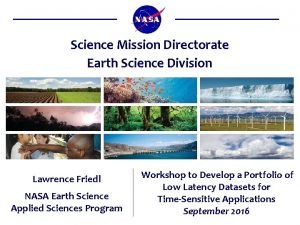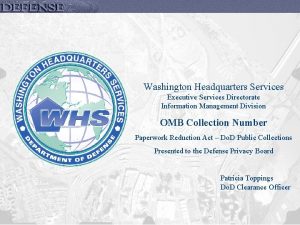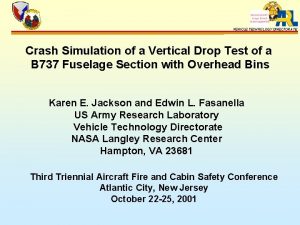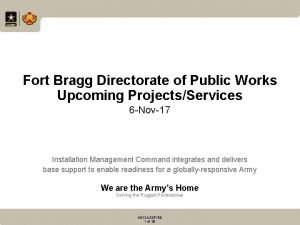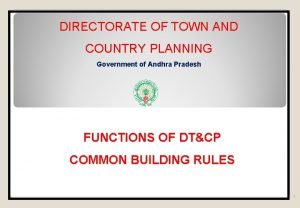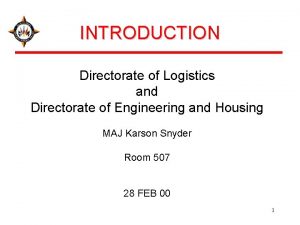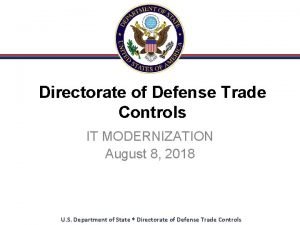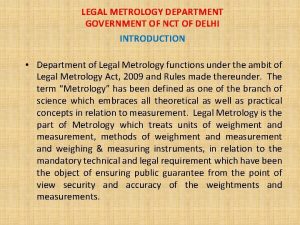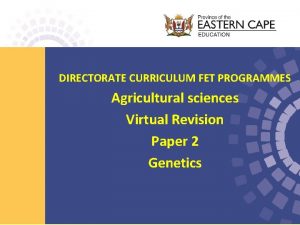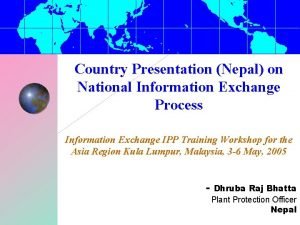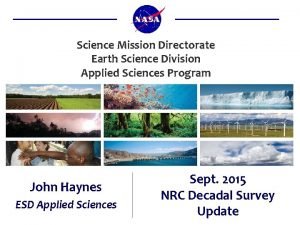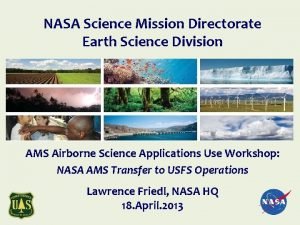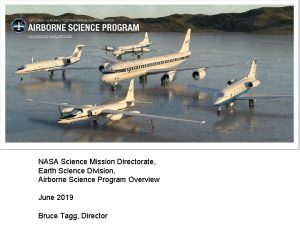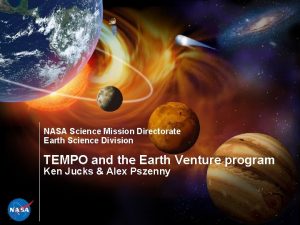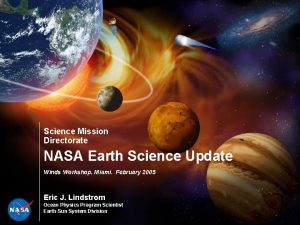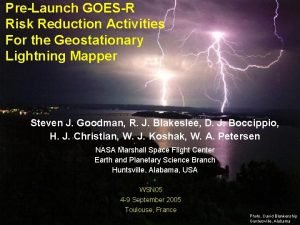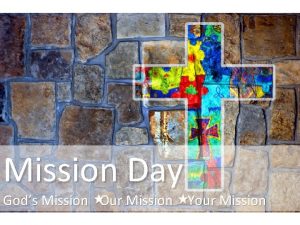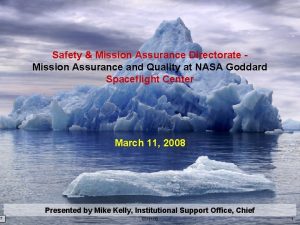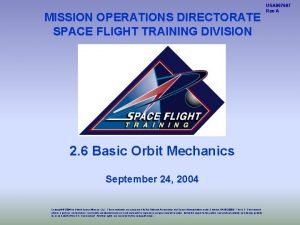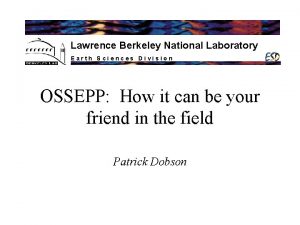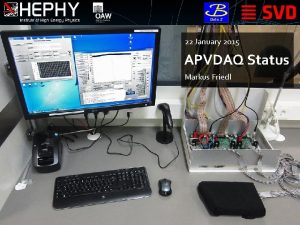Science Mission Directorate Earth Science Division Lawrence Friedl



















- Slides: 19

Science Mission Directorate Earth Science Division Lawrence Friedl NASA Earth Science Applied Sciences Program Workshop to Develop a Portfolio of Low Latency Datasets for Time-Sensitive Applications September 2016

Topics I. II. IV. V. Workshop on Low Latency USGEO: US Group on Earth Observations Satellite Needs Process 2 nd National Plan 2016 EO Assessment 2017 Decadal Survey Sept 2016 |2

An entity of the Committee on Environment, Natural Resources, and Sustainability (CENRS) The Purpose of USGEO is to: (1) coordinate, plan, and assess Federal Earth observation activities in cooperation with domestic stakeholders; (2) foster improved Earth system data management and interoperability throughout the Federal Government; and (3) engage international stakeholders by formulating the U. S. position for, and coordinating U. S. participation in, the intergovernmental Group on Earth Observations (GEO) USGEO Members: Department of Agriculture; Department of Commerce; Department of Defense; Department of Energy; Department of Homeland Security; Department of the Interior; Department of State; Department of Transportation; Environmental Protection Agency; NASA; National Science Foundation; Smithsonian Institution; U. S. Agency for International Development. Also represented: Office of Management and Budget Council on Environmental Quality Office of Science and Technology Policy.

USGEO: Satellite Needs Process In FY 16 budget, OMB assigned NASA the responsibility for all civilian Earthobserving satellites (sans NOAA for weather and space weather). OMB guidelines on this responsibility allow agencies to provide inputs to NASA for consideration of their needs for sustained measurements. USGEO developed a Satellite Needs Process, conducted annually: 1. User agencies identify their needs 2. USGEO Sat. Needs Working Group compiles inputs and gives inputs to NASA 3. NASA reviews inputs; interacts with agencies as needed; makes decisions Output: NASA informs agencies of decisions; provides explanation to OMB & OSTP on how it addressed inputs

NASA Role/Responsibilities Satellite Needs Process The agencies’ needs serve as inputs into NASA decisions on which satellite measurements to fund. NASA engages user agencies in tradeoffs of end-to-end costs, capabilities, and risks to see to what extent it can serve the need. NASA will look at creative ways to support inputs. An achievable 80% solution is better than an unachievable 100% one. NASA provides to OMB and OSTP a supplement to its budget request that explains how it addressed each user agency input. Approx. Schedule June-Sept: Agencies compile inputs By Dec. 1: NASA receives inputs and begins analysis and interactions June 1: NASA provides responses to agency needs ~ Sept. 1: With budget submit, NASA submits info to OMB on how it adjudicated the inputs

Sections of Inputs I. Federal Agency Information II. Context for Satellite Need Responsibility and Strategic Objective Supported by Satellite Data III. Satellite Measurement/Product Need Measurements and data products needed to meet the agency responsibility Data latency is one of the elements. DL ≡ time from when an observation is made by the satellite and receipt of the observation by the user IV. Value of the Data Products to Agency/Department Objective Benefits and impacts of the measurements and data products that serve the responsibility in Section II V. Additional Comments Satellite Needs Process General Categories Ø Data Continuity with Improvements Ø Unmet Data Needs

National Civil Earth Observations Plan Sec. 702 of the NASA Authorization Act of 2010 instructed the OSTP Director to: Ø Establish a mechanism to ensure greater coordination of the research, operations, and activities relating to civilian Earth observation of those Agencies, including NASA, that have active programs that either contribute directly or indirectly to these areas. Ø This mechanism should include the development of a strategic implementation plan that is updated at least every 3 years, and includes a process for external independent advisory input. Ø This plan should include a description of the responsibilities of the various Agency roles in Earth observations, recommended cost-sharing and procurement arrangements between Agencies and other entities, including international arrangements, … | 7

National Civil Earth Observations Plan Defined a framework for constructing a balanced portfolio of Earth observations and observing systems Classifies Earth-observation activities according to two broad categories: Sustained Observations: Measurements generally taken for seven years or more Experimental Observations: Measurements taken for a limited observing period generally for research or development purposes Sustained Observations: - For Public Services - For Earth System Research | 8

National Civil Earth Observations Plan Prioritization (with a balanced portfolio) 1. Continuity of sustained observations for public services 2. Continuity of sustained observations for Earth system research 3. Continued investment in experimental observations 4. Planned improvements to sustained observation networks and surveys for all observation categories 5. Continuity of, and improvements to, a rigorous assessment and prioritization process Supporting Actions • Coordinate and integrate observations • Improve data access, management, and interoperability • Increase efficiency and cost savings • Improve observation density and sampling • Maintain and support infrastructure • Explore commercial solutions • Maintain and strengthen international collaboration • Engage in stakeholder-driven innovation | 9

USGEO: Earth Obs. Assessment Provide a comprehensive quantitative assessment of the Nation’s current portfolio of Earth-observing systems that contribute to the provision of information products, public services, and research that provide societal benefit to the Nation. The goals of the Earth Observation Assessment are to: Ø Quantify the relative reliance of the Federal Government on individual Earthobserving systems, sensors, networks, and surveys Ø Identify unanticipated applications of Earth-observing sources that provide valuable services and deliver societal benefits (more than originally planned) Ø Assess the relative impact of individual Earth-observing sources on the provision of societal benefit Ø Provide an evidence-based reference for informing decisions within the Federal Government on the maintenance and continuity of existing Earth-observing inputs Ø Inform the development of the second National Plan for Civil Earth Observations

USGEO: Earth Obs. Assessment The results provide an evidence-based reference for informing Federal decisions on maintenance and continuity of existing Earth observation inputs and will inform OSTP’s development of the second National Plan for Civil Earth Observations. The results are a potentially powerful tool for future analyses, and can inform better interagency communication, engagement, and collaboration. EOAssessment & Latency was not a consideration of the Assessment. How can the Assessment results, when available, support the identification of data sets that would benefit from low latency capabilities?

Earth Science & Applications from Space The national strategy outlined here has as its overarching objective a program of scientific discovery and development of applications that will enhance economic competitiveness, protect life and property, and assist in the stewardship of the planet for this and future generations. … a decadal program of Earth science research and applications in support of society – a vision that includes advances in fundamental understanding of the Earth system and increased application of this understanding to serve the nation and the people of the world. 2007 Earth Science Decadal Survey | 12

Earth Science & Applications from Space The national strategy outlined here has as its overarching objective a program of scientific discovery and development of applications that will enhance economic competitiveness, protect life and property, and assist in the stewardship of the planet for this and future generations. … a decadal program of Earth science research and applications in support of society – a vision that includes advances in fundamental understanding of the Earth system and increased application of this understanding to serve the nation and the people of the world. NASA defines science to include research, applied research, and applications. The relative emphasis on each is unique to an individual investigation. 2007 Earth Science Decadal Survey | 13

2 nd Earth Science Decadal Survey STATEMENT OF TASK Bill Gail Global Wx Corp. Assess progress in addressing the major scientific and application challenges outlined in 2007 Earth Sci. Decadal Survey. Develop prioritized list of top-level science and application objectives to guide space-based Earth obs. over a 10 -year period Identify gaps and opportunities in the programs of record at NASA, NOAA, and USGS in pursuit of the top-level science and application challenges—including space-based opportunities that provide both sustained and experimental obs. Recommend approaches to facilitate the development of a robust, resilient, and appropriately balanced U. S. program of Earth observations from space. http: //www. nas. edu/esas 2017 | 14

2 nd Earth Science Decadal Survey STATEMENT OF TASK, CONT. Bill Gail Global Wx Corp. Recommend NASA research activities to advance Earth system science and applications by means of a set of prioritized strategic “science targets” for the spacebased observation opportunities in the decade 2018 -2027. A science target in this instance comprises a set of science objectives that could be pursued and significantly advanced by means of a space- based observation. … For each science target, the committee will identify a set of objectives and measurement requirements/capabilities for space-based data acquisitions. http: //www. nas. edu/esas 2017 | 15

2 nd Earth Science Decadal Survey DECADAL SURVEY STUDY PANELS DATA LATENCY I. Global Hydrological Cycles and Water Resources Will and how will this Decadal Survey address the topic of data latency? II. Weather and Air Quality: Minutes to Subseasonal - Technology development? III. Marine and Terrestrial Ecosystems and Natural Resource Management - Data systems? IV. Climate Variability and Change: Seasonal to Centennial - Decision support? V. Earth Surface and Interior: Dynamics and Hazards - Research opportunities? - Societal benefits? | 16

2 nd Earth Science Decadal Survey STATEMENT OF TASK: NASA EARTH SCIENCE For NASA Earth Science Division, the committee will pay particular attention to prioritizing and recommending balances among the full suite of Earth system science research, technology development, flight mission development and operation, and applications/capacity building development. In particular, the committee will make recommendations on: ESD Portfolio: Budgetary balance between Flight and Non-Flight aspects Non-Flight Portion: » Target balance between Research, Applied Sciences, and Technology » Any changes in scope(s) of Research, Applied Sciences, and Technology Flight Portion: Balance of new measurements vs. time-series extensions of existing data sets (i. e. , relative importance of continuing an existing mission with a follow-on and the initiation of a new mission/measurement) | 17

Questions I. II. IV. V. USGEO: US Group on Earth Observations Satellite Needs Process 2 nd National Plan 2016 EO Assessment 2017 Decadal Survey Workshop on Low Latency Sept 2016 | 18

Science Mission Directorate Earth Science Division Back-up Materials Workshop to Develop a Portfolio of Low Latency Datasets for Time-Sensitive Applications September 2016
 Lawrence friedl nasa
Lawrence friedl nasa Hsarpa
Hsarpa Executive services directorate
Executive services directorate Veterinary medicines directorate
Veterinary medicines directorate Vehicle technology directorate
Vehicle technology directorate Norwegian directorate of health registration
Norwegian directorate of health registration Early childhood directorate nsw
Early childhood directorate nsw Government of karnataka department of technical education
Government of karnataka department of technical education Fort stewart dpw
Fort stewart dpw Directorate of town & country planning
Directorate of town & country planning European directorate for the quality of medicines
European directorate for the quality of medicines Technology applications ec-12
Technology applications ec-12 Directorate of logistics
Directorate of logistics Deccs help desk
Deccs help desk Directorate general for competition
Directorate general for competition Marketed health products directorate
Marketed health products directorate Norwegian directorate for education and training
Norwegian directorate for education and training Legal metrology department
Legal metrology department Directorate curriculum fet
Directorate curriculum fet Plant protection directorate nepal
Plant protection directorate nepal
